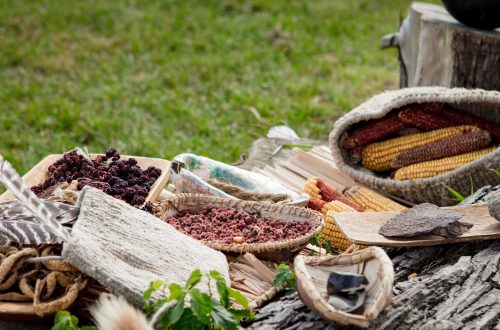
Down in Jamaica
Now that the days are getting warmer, we can start to think about outdoor grilling. One of the favorite grill recipes in this house is Jamaican jerk. We served our own homemade jerk chicken at our wedding (although we had to search high and low for a recipe back then) and have continued to use those recipes over the years. That got us thinking about Jamaican food as a cuisine that needs further examination.
Turns out that when Columbus visited the island in 1494, the local Taino tribe served him seasoned meats that made him sweat, according to accounts written at the time. Even before the Europeans and other immigrants arrived, the rich land in Jamaica produced cassava, sweet potatoes, corn, bananas, plantains, peas, kidney beans, and allspice. It was those Scotch Bonnet peppers that imparted the heat for the visiting explorer’s barbecue. The native Tainos, who called their homeland Xaymaca, “land of wood and water,” had lived there for almost 1,000 years before the Spanish arrived. Their diet comprised mostly fish and vegetables. The Arawak language spoken by the Taino also gave us the words barbecue, hammock, hurricane, tobacco, and canoe.
As for the modern foods of Jamaica, while grounded in the local plants and produce, the cuisine was influenced by its history of invaders and immigrants. The Spanish, who forced the native residents into slavery, then began importing enslaved people from Africa to work on plantations that supplied food for the Spanish ships that sailed between Europe and the Americas. The enslaved were the source of the African influences on cuisine with dishes such as callaloo, originally from Angola. The Spanish settlers introduced escabeche fish (also spelled escovitch), a Jamaican specialty.
Coffee and sugar
When the English captured the island from the Spanish in 1655, many of the indigenous and African people escaped into the hilly interior and developed their own separate culture. It’s in the Blue Mountains that they began cultivating coffee, which was introduced to the island from Ethiopia in 1728 and is now considered among the best in the world. The British continued to import enslaved labor to work on sugar production. However, the slave trade was abolished in 1807, resulting in the collapse of the plantation system. Without slavery, the plantation owners began bringing in indentured servants to work the sugar plantations. The first were from India, but later, the British also brought in Chinese.
Together, all these different migrant groups brought their food traditions to the island where they adapted their recipes to make use of the local meat and vegetables, all with a little spice. The last major influence on Jamaican cuisine were the Rastafarians, who grew out of disenfranchised Afro-Jamaican people in the 1930s. The Rastas produce their food “naturally,” typically meaning organic and local, and avoid eating pork or crustaceans.
Spices and hot peppers
So what can you expect from authentic Jamaican food? First, you will likely encounter the power of jerk spices, a dry rub for meats and seafood which combines the Scotch Bonnet peppers with spices including cloves, cinnamon, nutmeg, scallions, thyme, garlic, and black pepper. After marinating in this rub, the meat is traditionally smoked over wood.
You’ll also likely find a beef patty that is the Jamaican version of a British or Cornish pasty, though the meat is typically curried and usually spicy. Ackee and saltfish is a dish that adopts the ackee, a fruit brought from Africa and is sautéed with salted fish, tomatoes, onions, and chili peppers. If you encounter a Jamaican curry, you’ll probably be eating goat meat marinated in a powder heavy on turmeric with paprika, cumin, cardamom, and garlic and sautéed until the meat is tender.
Callaloo, bammy, and chocho
In Jamaica, you’ll likely also come across a vegetable side dish of callaloo, a leafy vegetable we’d identify as amaranth or taro. (In the U.S., you can substitute a three-to-one combination of spinach and collard greens.) You might also encounter fried breadfruit and bammy, a type of flatbread made from ground-up cassava. Then there’s chocho (chayote), a type of squash belonging to the gourd family, that’s best enjoyed in savory dishes such as soups and stews. The pear-shaped fruit is somewhat bland when raw, but tastes like a cross between cucumber and potato when cooked in dishes such as this chocho curry.
In all, it’s one of the most interesting cuisines to be found, unique because of its isolated island origins, together with the core spices and flavoring blends that have been passed along to cooks throughout generations.
What’s your experience with Jamaican food – or jerk, for that matter?
From your email, please click on the headline to view the blog on the website. You can log in and comment at the end of the blog to share your thoughts and start a discussion, or suggest a topic for Farmboy in the Kitchen.
If you’d like to share the blog, click on the Facebook icon or one of the others. Thanks!




